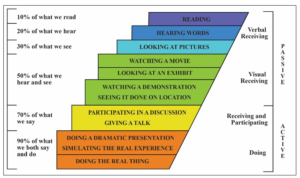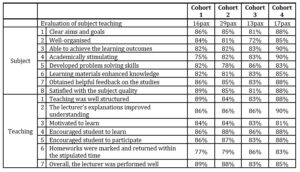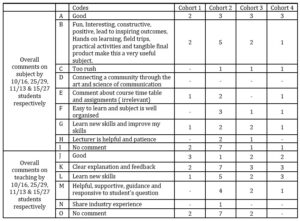Introduction
The program standard for Art & Design under the Malaysia Quality Agency (MQA) emphasised that design focuses on aesthetics, concept, function, creativity, and innovation (MQA, 2018). Students are expected to synthesise and apply relevant knowledge practically and effectively (MQA, 2018, pp 8) and achieve the outcomes at the end of the learning curve. The social competence of students is also a key factor that has to look into it in order to cope with the pace of the market trend and the consciousness of the environment (Uya & Yesilpinar, 2017), as the present youth’s knowledge about sustainability is considerably weak (Mahat, Hashim, Saleh, Nayan, & Norkhaidi, 2019), it is also the mission of the instructors to uplift the practice of environmentally responsible behaviour to in line with the courses that they are nurturing the new generation or else it might pestilential to the future (Lampa, Greculescu, and Todorescu, 2013).
The youth in this study refers to four cohorts of participants who grew up in the digital world, studying bachelor’s degree in graphic design in one of the higher education institutions in Malaysia’s capital city, Kuala Lumpur. A Print design course which the curriculum is to teach students to create and design layouts of books, in addition to using the traditional method of desktop publishing, the course was extended to motion graphics by emphasising the integration of video, audio, and animation into the book with Augmented Reality (AR), it allows students to showcase their digital information and media in creativity through the physical book; meanwhile, researchers deployed explanatory mixed-method research, initiated by a descriptive analysis with five-point likert scale questionnaire then thematic analyse on the open-ended survey to study the effectiveness of incorporating AR in print design course based on the students feedback in the area of subject and teaching, to improve the syllabus of the print design course in the future.
Higher Education Providers In Malaysia
The Ministry of Higher Education governs all the higher education providers (HEPs) in Malaysia. Furthermore, all the programs conducted in higher education institutions (HEI) need to meet the program standard set by Malaysia Quality Agency (MQA). According to the guideline stated for the Art & Design program, which is forwarded to all HEI that provide Art & Design programs, the emphasis is on design focuses on aesthetics, concept, function, creativity, and innovation (MQA, 2018 Nov 2020). , Hence HEPs are encouraged to go beyond the basic minimum where HEPs should be innovative in customising, organising, delivering, and assessing, and meeting the current and future needs of the industry, society, and country. Hence, HEPs must take cognisance of the rapidly evolving subject matter and introduce effective and sustainable program improvements.
Since 2018, MQA has set the criteria for Art & Design programs to attain a set of desired learning outcomes at the end of the program, with appropriate instructional approaches and assessment mechanisms (COPPA 2nd Edition, 2017). The five clusters of the learning outcomes are meant to develop a well-balanced individual with a holistic set of competencies. However, the HEPs have the flexibility in describing and covering the five clusters of the learning outcomes within the courses of each of the particular programs. The five clusters set by the MQA are:
1.Knowledge and Understanding,
2.Cognitive Skills,
3.Functional Work Skills with a focus on:
- Practical Skills
- Interpersonal Skills
- Communication Skills
- Digital Skills
- Numeracy Skills
- Leadership, Autonomy, and Responsibility
4.Personal and Entrepreneurial Skills
5.Ethics and Professionalism
Body of Knowledge In Graphic Design Program in HEI
The undergraduate program in Graphic Design revolves around the practice of conceptualising and visualising ideas with creative, critical, and technical skills. It produces graduates who are flexible and responsive. The medium of communication can be physical and or digital, including images, illustrations, texts, and graphic elements.
Body of knowledge for graphic design listed in the programme standards of the 2nd Edition published by Malaysian Qualification Agency in November 2020, includes Computer-Aided Design (CAD), branding, photography, visual and Media Culture, Professional Practice, Design History, Drawing & Illustration, Typography, Visual Communication, Design Communication, Environmental Graphic Design, Electronic Publishing, Packaging Design, Media and time-based art and Art Direction.
Print Design (Electronic Publishing) Course
Print design course leading the students to learn from setting up the workspace and structuring the documents through to the basics of typesetting, applying colours and images to designing a book. They are exposed to the fundamentals, techniques, and trends in publishing required and equipped with the skills to create rich multimedia content, the concept of digital graphics for print.
Motion Graphic Course incorporates with Augmented Reality (AR)
Motion Graphics
Creating mood boards, visuals or layouts, storyboards, keyframes, visual styling, technique, and media are parts of the pre-production stage for motion graphics. Meanwhile, planning on locations, settings, use of rostrum cameras, tripods, zoom, perspective, lighting, special effects, baseboards, time of day, model boxes, environments, and audio also needs to consider if the presentation is in video shooting.
Augmented Reality
AR technology can be defined as a real-time physical, real-world environment enhanced by adding virtual information generated by digital (Furht, 2011, Peddie, 2017). The images’ scaling and shaping are fused with the natural environment. Today, all smartphones can perform the AR technology requirements or be defined as using computer technology to superimpose virtual information onto the real world by displaying it on electronic devices. Presently, the most mature technology and widely used AR in Malaysia is recognition-based, which through the camera perceives the corresponding mark of a two-dimensional code to activate AR visualisation (Gao & Wong, 2015). Learner Interest Since 1969, Edgar Dale’s Cone of Experience has illustrated the importance of concrete experience and direct participation to provide the foundation of permanent learning and communication. It is enabled viewers or users to have an engaging perception and interaction by gaining experiences virtually (Peddie, 2017, p. 8-9). It is a visual analogy of a revolutionary approach to improving the quality of educational learning environments by exposing the students to a hands-on and realistic experience that can provide vivid understanding, motivation, participation, and engagement. Malaysian researcher Dr. Siti Hajar Halili reported that technological advancement could bolster learner interest (Halili, 2019). “Implementation of AR in print books would add life and motion to print books, thus allaying boredom quoted by Siek (2020 (See Figure 1).

Fig 1. Adapted Cone of experience. Educational technology: An encyclopedia, 7
(Molenda, 2003)
Course Description and Outcomes Learning for Courses
For the Print Design course, to fulfil the requirements of the study and meet the appropriate program standards, students were introduced to design knowledge of various publication layouts, organising documents, the material, and printing methods for traditional printing. Upon completing this subject, students will have the necessary skills to achieve professional-looking results easily. With both knowledge and skills, students will be able to manipulate ideas and concepts into forms of visual communications. For the motion graphics course, each participant was expected to do research based on given topics, sketch out their storyboard, experiment with digital animations, do live video shooting, and add audio (Lee, 2012) to the design of a physical book. It provides unprecedented interactivity and real-time experience to readers, which the learner must achieve. It demonstrates the understanding of reaching out to the intended target audience by developing an appropriate storyboard and script, utilising personal visual abilities and skills.
Project Brief, Research of Two Courses
- Print Design Project Brief Each student was asked to prepare four local content narratives ( Rahim & Pawanteh, 2010). Each of the narratives is only allowed to present in two pages (open page). Participants were expected to do research based on titles and story ideas without word limits. They are to apply the design knowledge they had learned by using grids, columns, layout, and images for the pages.
- Motion Graphics Project Brief The project enables students to improve their ability to communicate to a specified target audience using moving image design by generating their imagery, dialogue, and the soundtrack by documenting the output coherently and delivering it through time-based media by AR as a final medium of communication, helps to reduce the number of pages.
Produce a written script of their visual story, including any visual and audio effects they may intend to have in their motion graphics video.
Under the project brief, students are required to produce a storyboard to communicate the narrative based on the collaboration with the Print Design course and present it in AR, closing the gap between physical and digital and allowing the students to know that they have a role to play in trying to reduce their collective impact on the world.
Research Methods
This study used a mixed-methods approach (quan-QUAL) to evaluate the factors that influence students’ satisfaction with the outcome and their readiness to suggest the AR learning in print design course in two years through four cohorts of students’ feedback. The student feedback was obtained through the university database, and students’ participation was entirely self-volunteered.
Descriptive Analysis
The evaluation was taken into both the lecturers’ teaching and subject to understand the students’ comprehension and satisfaction of the subject. Table 1 shows four cohorts of student’s feedback. The percentage shows the average score from a 5-point Likert scale of (1) strongly disagree and (5) strongly agree.
Table 1: Survey questionnaire based on cohort 1-4 students’ feedback

Through the feedback survey result from the subject itself for the four cohorts, with a total of 75 students and 61 out of 75 had completed the survey. We understand that over 80% of the students are clear with the aims and goals of the subject. They can achieve the remaining seven items with a clear goal, as the subject has been taught throughout the first year. The lecturer is more experienced in handling the students. In cohort 4, students’ feedback on (3) Able to achieve the learning outcomes and (4) Academically stimulating have achieved the highest percentage of agreement which is 90%. In contrast, the lowest percentage is 72% in cohort 3, item (2) Well-organised. It can be seen that the learning outcomes and the learning experience give higher satisfaction to the students and other items that were between 72 – 89 %. Besides the subjects, seven items from teaching from the questionnaire have also shown students high average agreement percentages. There are five items, particularly (1), (2), (4), (5), (7), that were able to achieve 88-90% in parts of the cohorts. From the result, teaching was well organised, explanation of the instructions increases students’ comprehension and supports participation.
Thematic analysis
The open-ended question was analysed using thematic analysis to analyse the quantitative data from Table 1 further. A six steps thematic analysis by Braun & Clarke (2006) was used to extract the students’ feedback based on the patterns and themes. They are familiarisation, coding, generating themes, reviewing themes, defining and naming them, and writing up to report the themes based on the study.
Familiarisation and coding
To begin, researchers familiarise themselves with the data by browsing and reading the collected materials, comprehending the content of students’ feedback on instruction and the issue of implementing augmented reality in print design.The researcher then divides the content into brief sentences or phrases and translate them into short labels. The researchers attempted to summarise and aggregate the codes into nine subject-specific and six teaching-related codes.
Table 2: Open-ended questionnaire codes based on cohort 1-4 students’ feedback

Findings and Discussion
Based on the open-ended questionnaire, the interview has been coded into 15 codes from A to O as shown in Table 2, nine on the subjects and six on the teaching following with the 4 main steps below:
Generation of Themes
After coding all data, filtering and scrutinising the codes generated from the open-ended questions from student feedback, identifying their patterns, and categorising them, seven general themes from teaching and subject have emerged. They are the mixture of all 15 codes, (1) informative, B, F, N, (2) Ease of learning from F, G, H, and M, (3) Connection with materials and lecturers, from D, H and M, (4) motivation of learning, B, J, K, L and M, (5) neutral experience J, O, (6) negative condition, C (7) Positive subject experience, A, J, F, K, M. These themes are effectively a superset of codes.
Reviewing Themes
The researchers take a second, third, and even fourth view at the generated codes and identify which ones are essential and accurate representations of the data related to the research purpose.
Defining and Naming the Themes
Following the examination of themes, the following stage is to name and define the titles of the topics. The titles of selected topics must be digestible and convey the purpose and function of each subject.
After reviewing the themes, three themes were confirmed, (5) neutral experience and (6) negative condition were not included as the feedback are irrelevant to the effectiveness of the learning in this subject using AR:
Theme 1: Constructive
This theme was the category from the result from (1) informative, (2) ease of learning
Theme 2: Learning oriented
This theme was the category from the result from (1) informative, (4) motivation of learning
Theme 3: Positive Connection of learning with material and instructor
This theme was the category from (3) connection with materials, (7) positive subject experience
Write Up/ Reporting
Finally, organise findings into understandable words, phrases, and paragraphs. The results and implications section demonstrates the study objective or responds to the research question based on the identified topics. The final three themes from section 3.2.3 are closely related to the quantitative survey feedback of the students. In the survey above, a higher percentage of students agreed that the subject enabled them to achieve the learning outcomes and intellectually to stimulate, which is a match with theme 1: constructive, Then Learning resources assisted the learning, Encouraged students to learn and participate is matching with theme two on learning-oriented. Lastly, the lecturer’s explanations helped in understanding the quality of this subject is satisfying and Learning resources assisted the learning match theme 3: Connection of learning with material and instructor.
Conclusion and Future Directions
This study will be a guideline to the university’s teachers/instructors to teach their students the print design subject effectively. The results show that most of the students’ feedback is positive towards the subject and teaching in the quantitative result. It shows a relatively biased score of agreement from 72-90%. Therefore, to gain a firmer result from the quantitative result, a thematic analysis on the open-ended questions shows three main themes constructive, learning-oriented and positive connection of learning are the factors of effectiveness in a print design course. With these three themes analysed, the effectiveness of AR in print learning design also shows the students constructive way of building up their knowledge, with a mindset of learning new knowledge and positivity connection of the students with their learning materials with instructors or lecturers. However, this study takes fewer participants for each cohort and no control group to compare treatment. Therefore, it would take more than two years to test the students’ effectiveness. Further expansion of the research would be on evaluating only on teaching or the subject itself.
References
- Alhojailan, M. I. and Ibrahim, M. (2012). ‘Thematic Analysis : A Critical Review of Its Process and Evaluation.’ West East Journal of Social Sciences, International European Academic Conference Proceedings, 1(2011), 8–21.
- Braun, V. and Clarke, V. (2006). ‘Using thematic analysis in psychology.’ Qualitative Research in Psychology, 3(2), 77–101. https://doi.org/10.1191/1478088706qp063oa
- Furht, Borko. 2011. Handbook of Augmented Reality. New York: Springer.
- Halili, S. H. ( 2019 ). ‘Technological Advancements in Education 4.0.’ The Online Journal of Distance Education and e-Learning, 7 (1).
- Lampa, I., Greculescu, A.and Todorescu, L.-L (2013). ‘Education for Sustainable Development -Training the Young Generation for the Future.’ Procedia – Social and Behavioral Sciences, 120-124.
- Lee, K. (2012). ‘Augmented Reality in Education and Training.’ Techtrends Tech Trends 56, 13–21. https://doi.org/10.1007/s11528-012-0559-3.
- Mahat, H., Hashim, M., Saleh, Y., Nayan, N. and Norkhaidi, S. (2019). ‘Environmental Sustainability Knowledge, Attitude and Practices among Pre-school Students.’ IPO Conference Series: Earth and Environmental Science.
- Malaysian Qualifications Agency. (2018). Code of Practice for Programme Accreditation. Cyberjaya: Malaysian Qualifications Agency.
- Mohr, K. A. (2017). ‘Understanding Generation Z Students to Promote a Contemporary Learning Environment.’ Journal on Empowering Teaching Excellence, 1(1), Article 9.
- Peddie, Jon. (2017). Augmented Reality. Switzerland: Springer.
- Rahim, S. A. and Pawanteh, L. (2010). ‘The local content industry and cultural identity in Malaysia.’ Journal of Media and Communication Studies, Vol. 2(10), pp. 215-220.
- Sell, K. and Lynch, D. E. (2014). The Teacher as Researcher: Case studies in educational research. Tarragindi: Oxford Global Press.
- Uya, and Yesilpinar, M. (2017). ‘Perceptions of Students from the Department of Computer Education and Instructional Technologies Regarding the Concept of Curriculum.’ International Education Studies, 10, 9-22.
- Xu, F., Shan, W. J., Bai, Y., Yang, J., Cai, Q. and Li, Z. (2016). Tracing in the Development Context of Curriculum. Taipei: Higher Education Publisher.





